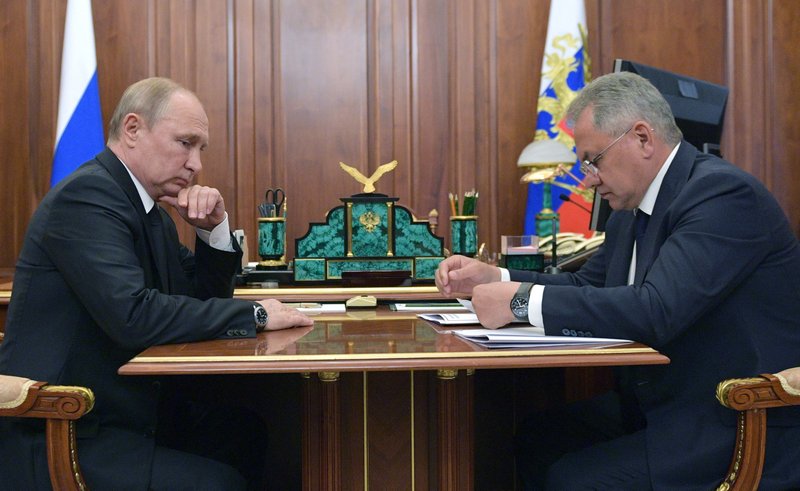Russian defense chief says there are survivors of navy fire
By VLADIMIR ISACHENKOV
30 minutes ago
03 July 2019

Russian President Vladimir Putin listens to Russian Defense Minister Sergei Shoigu during their meeting in the Kremlin in Moscow, Russia, Tuesday, July 2, 2019. A fire on one of the Russian navy's deep-sea submersibles killed 14 sailors, the Russian Defense Ministry said Tuesday without giving the cause of the blaze or saying if there were survivors. (Alexei Druzhinin, Sputnik, Kremlin Pool Photo via AP)
MOSCOW (AP) — Some crew members have survived a fire that killed 14 sailors onboard one of the Russian navy’s deep-sea research submersibles, the nation’s defense minister said Wednesday.
Sergei Shoigu didn’t specify how many crew members were rescued from Monday’s fire. Speaking at the navy’s Arctic base of Severomorsk, he praised the vessel’s crew for “heroic” action, saying they sacrificed their lives to rescue a civilian expert and save the ship after the fire erupted.
Details were scarce about the incident on the ship, which was on a mission to measure sea depths in Russia’s territorial waters in the Barents Sea. The Defense Ministry said the seamen were killed by toxic fumes from the blaze, but did not specify how many crew members were aboard.
The ministry didn’t name the vessel, but Russian media reported it was the country’s most secret submersible, a nuclear-powered research submarine called the Losharik intended for sensitive missions at great depths.
Few images and details have emerged about the vessel. In 2012, the Losharik was involved in research intended to prove Russia’s claim on the vast Arctic seabed. It collected samples from a depth of 2,500 meters (8,202 feet), according to official statements at the time. Regular submarines can typically dive only to depths of up to 600 meters (2,000 feet).
President Vladimir Putin, who summoned Shoigu Tuesday to report on the fire, said in televised comments that seven of the dead had the rank of captain and two were awarded the nation’s highest medal, the Hero of Russia.
“It’s a huge loss for the navy,” Putin said.
Russian media on Wednesday identified some of the victims, including the ship’s captain, Denis Dolonskiy, who was awarded the Hero of Russia medal for the 2012 Arctic seabed research mission.
Shoigu, speaking during a meeting with officials investigating the fire, said those who died were “high professionals” and “unique experts.”
“The submariners acted heroically in the critical situation,” he said. “They evacuated a civilian expert from the compartment that was engulfed by fire and shut the door to prevent the fire from spreading further and fought for the ship’s survival until the end.”
Putin’s spokesman Dmitry Peskov refused to answer questions about the vessel’s name, design and mission, saying that the information is confidential.
A Vatican spokesman said Pope Francis has been informed of the fire and “expresses his condolences and closeness to the families and the victims affected by the disaster.” Putin is set to visit the Vatican Thursday for a meeting with the pope.
The blaze marks the most serious Russian naval accident since 2008, when 20 crew members died aboard the nuclear-powered Nerpa submarine in the Pacific Fleet when a firefighting system was accidentally initiated.
The Losharik is named after a Soviet-era animated cartoon horse made up of small spheres — a reference to the unique design of its interior hull, reportedly made of a chain of titanium spheres capable of withstanding colossal pressure at great depths.
Media reports speculated that it likely has features similar to the U.S. deep submergence vessel, the NR-1, which was mothballed in 2008 after nearly 40 years of service.
But unlike the NR-1 that was designed to dive to 910 meters (3,000 feet), the Losharik was built to go far deeper.
Some observers speculated the Losharik was even capable of going as deep as 6,000 meters (19,685 feet), but the claims couldn’t be independently confirmed. Analysts suggested that one of its possible missions could be disrupting communication cables on the seabed.
In Russia’s worst submarine disaster, the Kursk nuclear submarine suffered an explosion and sank during naval maneuvers in the Barents Sea on Aug. 12, 2000, killing all 118 crewmembers. Putin, who was in his first year of his presidency, came under heavy criticism at the time when he failed to immediately interrupt his vacation to handle the catastrophe.
___
Colleen Barry in Milan contributed to this report.

 www.apnews.com
www.apnews.com
By VLADIMIR ISACHENKOV
30 minutes ago
03 July 2019

Russian President Vladimir Putin listens to Russian Defense Minister Sergei Shoigu during their meeting in the Kremlin in Moscow, Russia, Tuesday, July 2, 2019. A fire on one of the Russian navy's deep-sea submersibles killed 14 sailors, the Russian Defense Ministry said Tuesday without giving the cause of the blaze or saying if there were survivors. (Alexei Druzhinin, Sputnik, Kremlin Pool Photo via AP)
MOSCOW (AP) — Some crew members have survived a fire that killed 14 sailors onboard one of the Russian navy’s deep-sea research submersibles, the nation’s defense minister said Wednesday.
Sergei Shoigu didn’t specify how many crew members were rescued from Monday’s fire. Speaking at the navy’s Arctic base of Severomorsk, he praised the vessel’s crew for “heroic” action, saying they sacrificed their lives to rescue a civilian expert and save the ship after the fire erupted.
Details were scarce about the incident on the ship, which was on a mission to measure sea depths in Russia’s territorial waters in the Barents Sea. The Defense Ministry said the seamen were killed by toxic fumes from the blaze, but did not specify how many crew members were aboard.
The ministry didn’t name the vessel, but Russian media reported it was the country’s most secret submersible, a nuclear-powered research submarine called the Losharik intended for sensitive missions at great depths.
Few images and details have emerged about the vessel. In 2012, the Losharik was involved in research intended to prove Russia’s claim on the vast Arctic seabed. It collected samples from a depth of 2,500 meters (8,202 feet), according to official statements at the time. Regular submarines can typically dive only to depths of up to 600 meters (2,000 feet).
President Vladimir Putin, who summoned Shoigu Tuesday to report on the fire, said in televised comments that seven of the dead had the rank of captain and two were awarded the nation’s highest medal, the Hero of Russia.
“It’s a huge loss for the navy,” Putin said.
Russian media on Wednesday identified some of the victims, including the ship’s captain, Denis Dolonskiy, who was awarded the Hero of Russia medal for the 2012 Arctic seabed research mission.
Shoigu, speaking during a meeting with officials investigating the fire, said those who died were “high professionals” and “unique experts.”
“The submariners acted heroically in the critical situation,” he said. “They evacuated a civilian expert from the compartment that was engulfed by fire and shut the door to prevent the fire from spreading further and fought for the ship’s survival until the end.”
Putin’s spokesman Dmitry Peskov refused to answer questions about the vessel’s name, design and mission, saying that the information is confidential.
A Vatican spokesman said Pope Francis has been informed of the fire and “expresses his condolences and closeness to the families and the victims affected by the disaster.” Putin is set to visit the Vatican Thursday for a meeting with the pope.
The blaze marks the most serious Russian naval accident since 2008, when 20 crew members died aboard the nuclear-powered Nerpa submarine in the Pacific Fleet when a firefighting system was accidentally initiated.
The Losharik is named after a Soviet-era animated cartoon horse made up of small spheres — a reference to the unique design of its interior hull, reportedly made of a chain of titanium spheres capable of withstanding colossal pressure at great depths.
Media reports speculated that it likely has features similar to the U.S. deep submergence vessel, the NR-1, which was mothballed in 2008 after nearly 40 years of service.
But unlike the NR-1 that was designed to dive to 910 meters (3,000 feet), the Losharik was built to go far deeper.
Some observers speculated the Losharik was even capable of going as deep as 6,000 meters (19,685 feet), but the claims couldn’t be independently confirmed. Analysts suggested that one of its possible missions could be disrupting communication cables on the seabed.
In Russia’s worst submarine disaster, the Kursk nuclear submarine suffered an explosion and sank during naval maneuvers in the Barents Sea on Aug. 12, 2000, killing all 118 crewmembers. Putin, who was in his first year of his presidency, came under heavy criticism at the time when he failed to immediately interrupt his vacation to handle the catastrophe.
___
Colleen Barry in Milan contributed to this report.

Russian defense chief says there are survivors of navy fire
Russia's defense minister says some crew members have survived a deadly fire that killed 14 sailors on a deep-sea research submersible.
